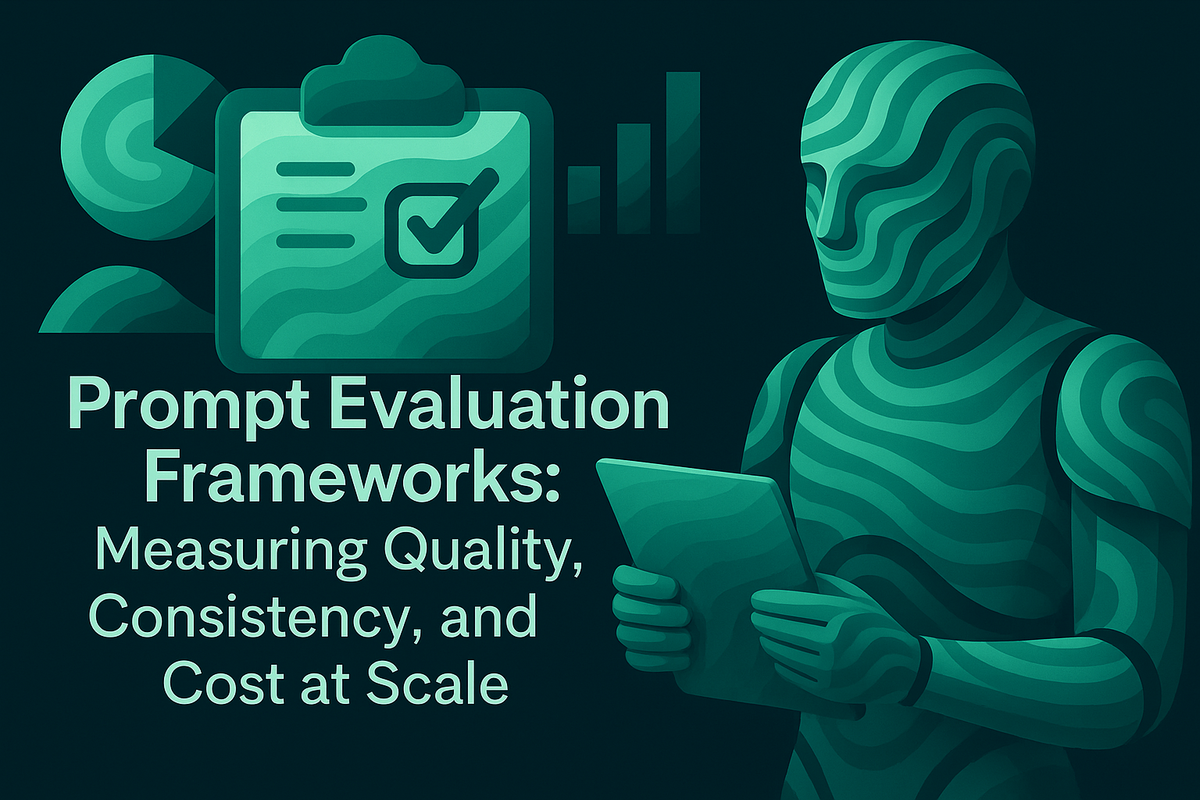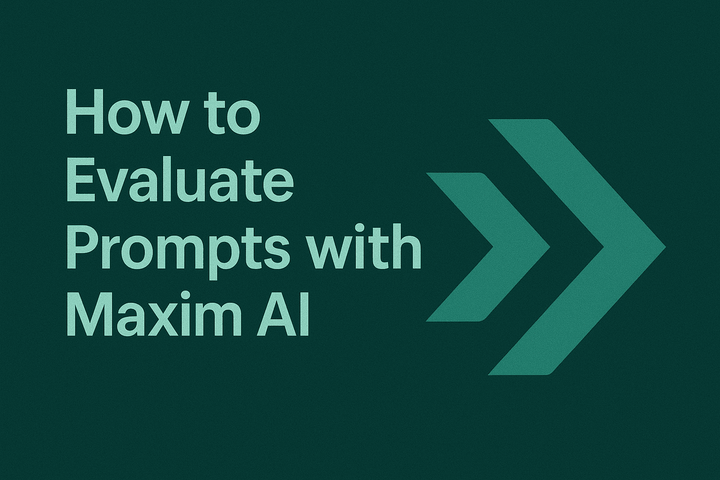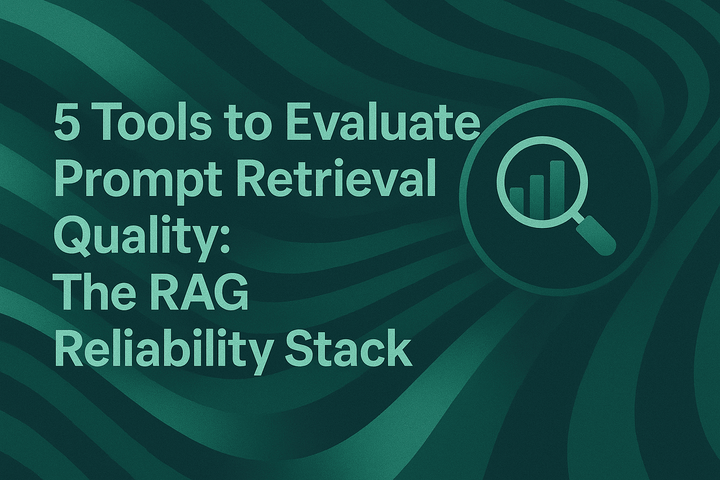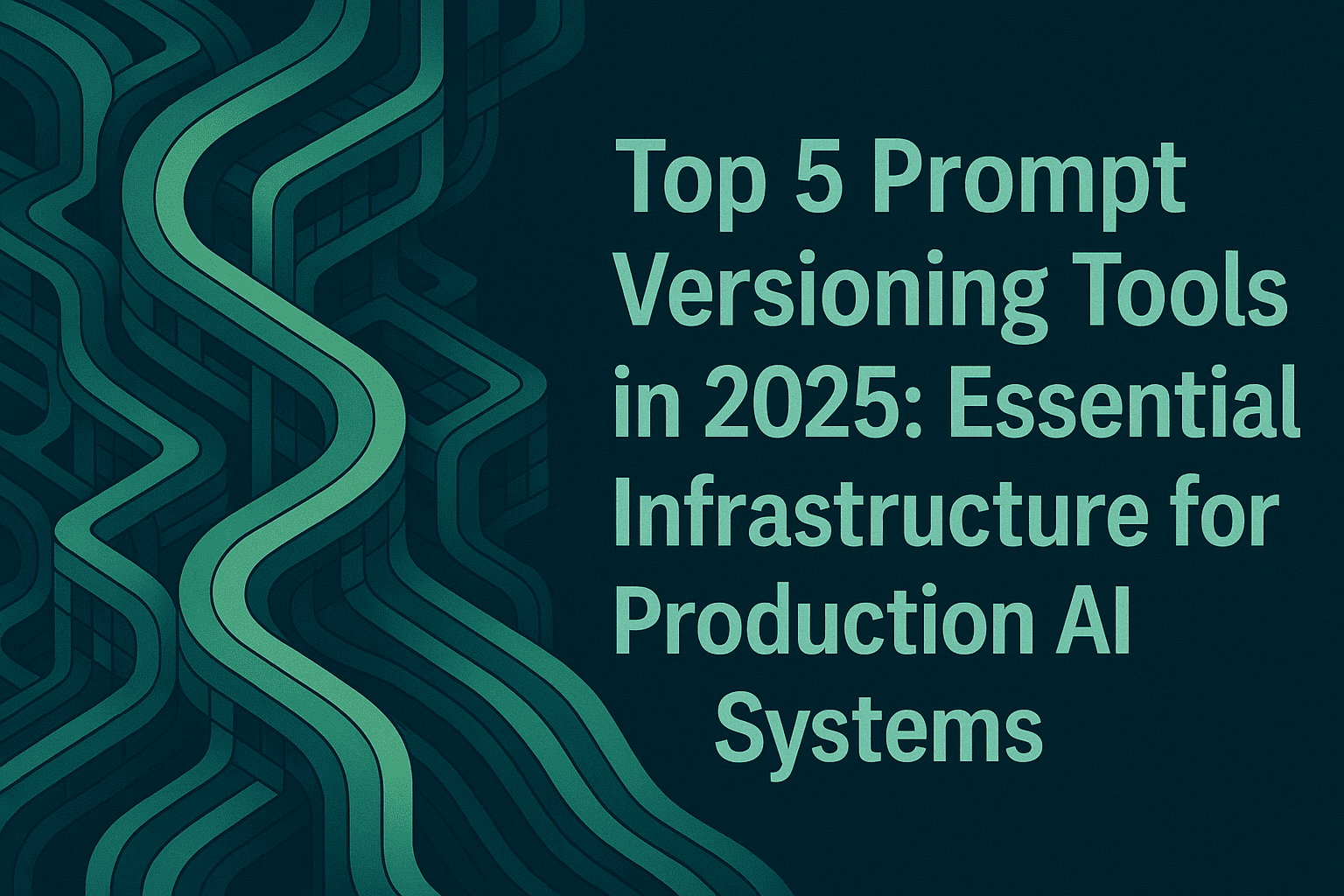Prompt Evaluation Frameworks: Measuring Quality, Consistency, and Cost at Scale

Introduction
Prompt evaluation has become a core engineering discipline for teams building agentic systems, RAG workflows, and voice agents. As we enter 2026, AI teams are moving from intuitive prompt design toward standardized, measurable evaluation. A structured framework ensures prompts deliver consistent quality, align with safety requirements, and meet cost and latency targets under real-world variability.
This blog outlines a practical, scalable approach to prompt evaluation that integrates offline experiments, multi-turn simulations, in-production monitoring, and human-in-the-loop review.
Why Prompt Evaluation Matters for AI Quality
Prompts act as the specification for model behavior. Small changes in instruction order, formatting, tool usage directives, or retrieval context can materially impact output faithfulness, tone, and latency.
A robust evaluation framework operationalizes prompt quality across the lifecycle by combining programmatic checks with AI and human judgments, then linking results to versioning and deployment decisions. Using LLM-as-a-Judge to score dimensions like coherence, faithfulness, safety, and bias provides scalable, nuanced assessments with rationales that complement quantitative metrics such as cost and latency.
This approach aligns with recent research on structured evaluation, such as Anthropic’s statistical approach to model evals and OpenAI’s Evals framework, which emphasize reproducibility and statistical confidence in evaluation results.
Without structured evaluation, prompt improvements remain anecdotal, not measurable.
Core Dimensions of Prompt Evaluation: Quality, Consistency, and Cost
Evaluation must quantify three key dimensions that define performance at scale:
- Quality: Correctness, faithfulness to source, relevance, helpfulness, safety, and tone alignment. Rubric-based evaluators produce explainable scores, improving auditability and consistency across datasets and versions.
- Consistency: Stability of outputs across datasets, versions, and models. Repeat trials and variance analysis detect regressions early and measure output reliability. Include cross-model comparisons and multi-turn scenario coverage to validate robustness.
- Cost: Token usage, latency, and runtime overhead across prompts, models, and tool-call strategies. Pair cost metrics with deployment variables and cohort filters to uncover trade-offs under real traffic patterns.
Prompt Evaluation Framework: Offline, Simulation, Online, and Human Review
A complete prompt evaluation framework spans four interconnected layers that cover the entire lifecycle:
- Offline prompt tests: Run bulk comparisons across prompt versions or models using curated datasets and evaluator templates. These establish baselines for clarity, safety, and latency before deployment while tracking token usage and cost metrics.
- Multi-turn simulation: Evaluate prompts in dynamic agent workflows, surfacing tool-call errors, retrieval failures, or reasoning gaps. Automated evaluators at node or span level enable granular diagnostics for debugging complex agent behaviors.
- Online monitoring: Instrument production traces for periodic quality checks and drift detection. Observability connects pre-deployment metrics with live performance, enabling continuous reliability measurement.
- Human-in-the-loop: Provide calibration for domain nuance, safety, and brand tone, blending sampled human reviews with automated evaluator rationales to refine rubrics and reduce bias.
This design aligns with Maxim’s broader observability and experimentation approach, ensuring parity between offline evaluation and production reliability.
Datasets and Coverage: Building Fit-for-Purpose Evaluation Sets
Reliable evaluation depends on coverage. Build datasets that reflect:
- Task diversity: Include requests that vary in complexity, ambiguity, and domain specificity. For RAG workflows, ensure coverage across retrieval difficulty, chunk sizes, and context assembly patterns.
- Scenario realism: Represent real-world multi-turn conversations that involve clarifications, retries, and tool calls. Align scenarios with production patterns using curated logs and labeled traces.
- Edge cases: Capture adversarial instructions, prompt injection attempts, and safety-sensitive content to test robustness and policy adherence under stress conditions.
For voice agents, include varied audio quality and accents to measure responsiveness and accuracy under realistic conditions. Link dataset entries to source-of-truth references for robust faithfulness scoring.
The closer your dataset mirrors production behavior, the more reliable your evaluation signal.
Designing Evaluators: Programmatic, Statistical, and LLM-as-a-Judge
A balanced evaluator stack turns complex outputs into measurable results:
- Programmatic checks: Deterministic validations for schema conformity, tool-call structure, argument formatting, and required fields.
- Statistical metrics: Latency distributions, token usage, and cost per request. Use percentiles to surface tail latency that affects user experience despite strong averages.
- LLM-as-a-Judge scoring: Rubric-based judgments across clarity, coherence, faithfulness, and bias. Few-shot examples and reasoning chains improve consistency. Apply node-level evaluators for agent tracing to pinpoint exact failure steps.
These multi-layer evaluators echo the hybrid evaluation methods discussed in “Beyond Standard Benchmarks: Evaluating AI Systems in Context”, which emphasizes task realism and process-based assessment.
Calibrate evaluator outputs against human annotations to ensure fairness and reproducibility. Review rationales regularly to refine rubrics and reduce ambiguity.
A/B and Cohort Testing: Comparing Prompt Versions at Scale
A/B testing brings empirical rigor to prompt iteration. Design experiments with:
- Clear objectives: Define specific improvement goals such as higher faithfulness, lower latency, or reduced hallucination rates.
- Randomized assignment: Ensure unbiased traffic distribution across prompt variants. Use deployment variables and filters to target cohorts safely.
- Metric bundles: Combine quality, consistency, and cost metrics to analyze trade-offs holistically. Avoid optimizing one dimension at the expense of others.
- Statistical rigor: Collect enough samples for confidence-based rollout decisions. Track variance to validate consistency improvements.
Running side-by-side comparisons with integrated evaluators enables transparent, evidence-driven versioning and promotion decisions.
Operationalizing Results: Versioning, Deployment, and Rollbacks
Evaluation results must directly inform how prompts ship:
- Version control: Link evaluation outcomes to prompt metadata, author history, and change descriptions. Promote only versions that meet defined success thresholds.
- Progressive rollout: Deploy safely using rule-based variables for cohorts and canary testing.
- Reproducible retrieval: Ensure agents always pull the evaluated prompt version using SDK filtering by tags and deployment variables.
- Rollback protocols: Automate reversions when live evaluators detect regressions or safety breaches. Link rollbacks to trace analysis for root-cause learning.
This operational discipline makes evaluation actionable — linking metrics directly to deployment and reliability decisions.
Evaluating Agent and RAG Prompts: Tool Calls, Retrieval, and Trajectory Faithfulness
Prompt evaluation frameworks must adapt to agentic and retrieval-based systems:
- Tool-call evaluation: Validate tool selection, argument correctness, and schema conformity.
- RAG evaluation: Assess precision, recall, relevance, and faithfulness of responses to retrieved sources. Include chunk-level inspection to validate citations.
- Trajectory analysis: Score multi-turn coherence, task completion, error handling, and recovery strategies.
For reference, see the recent AI Systems Evaluation Framework (arXiv:2504.16778), which underlines the importance of trajectory-level metrics for complex workflows.
Use trace analysis to pinpoint exact reasoning failures — essential for debugging and continuous improvement.
Observability and Continuous Monitoring: Closing the Loop
In production, prompt evaluation never stops. Ongoing measurement ensures sustained reliability:
- Distributed tracing: Capture spans for each prompt execution, tool call, and retrieval step.
- Automated checks: Run evaluator policies on live logs to detect faithfulness or latency drift. Alert teams when thresholds are breached.
- Data curation: Convert live traces into new evaluation datasets to keep tests relevant.
Observability ensures prompt reliability doesn’t end at deployment — it evolves with real usage, creating a continuous improvement loop.
Practical Workflow: From Experimentation to Deployment
A pragmatic workflow to operationalize prompt evaluation:
- Experiment in a prompt playground to compare models, variables, and tools.
- Build dataset coverage across multi-turn scenarios and RAG contexts with references for faithfulness scoring.
- Run A/B or cohort tests with randomized assignment and clear success criteria.
- Enforce versioning and gated promotion based on evaluation thresholds.
- Monitor live performance with tracing, alerts, and dataset curation. Iterate prompts based on findings.
This approach ties prompt engineering directly to trustworthy AI practices — enabling faster iteration grounded in evidence.
Best Practices and Common Pitfalls
Best Practices
- Anchor evaluation in clear rubrics and reproducible datasets.
- Combine programmatic checks, AI-based scoring, and human review.
- Treat consistency as a first-class metric alongside quality and cost.
- Use deployment variables to control experiments safely.
- Tie promotion decisions to predefined thresholds.
Common Pitfalls
- Insufficient sample sizes leading to noisy conclusions.
- Overfitting prompts to narrow test cases.
- Ignoring multi-turn dynamics or tool reliability.
- Weak traceability between evaluation results and deployed prompts.
- Overlooking tail latency impacts that harm user experience.
Conclusion
Prompt evaluation frameworks provide the structure needed to measure and improve AI quality, consistency, and cost at scale. A layered approach spanning offline testing, simulation, monitoring, and human review establishes a repeatable, auditable workflow from experiment to deployment.
By combining structured datasets, calibrated evaluators, and trace-integrated observability, teams can ship reliable agentic applications faster, while maintaining high standards of safety, faithfulness, and performance.
Ready to make prompt quality measurable? Book a demo or start for free.


